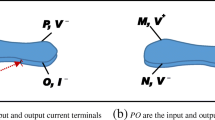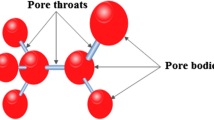Abstract
The behavior due to rainfall infiltrating the ground plays a role in landslides, groundwater recharge and various other ground responses. Most of these geotechnical behaviors have a correlation between soil pore space and soil volumetric water content in the unsaturated and saturated soil porous media. Therefore, the soil porosity associated with soil pores and the distribution of volumetric water content are significantly important hydrological characteristics. In the case of shallow slope failure such as landslide, the infiltration activity due to the connectivity of soil pore spaces in a porous media is induced. Slope failure may be attributed to the effect of a wetting front with the slope due to liquid infiltration, which changes the volumetric water content, soil matric suction and shear strength of the slope. This study was performed with an unsaturated injection test using a frequency domain reflectometry (FDR) dielectric device which measures the dielectric constant of unsaturated soil and the study then proposed the unsaturated dielectric mixing models to calculate soil porosity and effective porosity of unsaturated soils. From the experimental results the ratio of effective porosity to porosity of soils are measured in a range of 70–85%. These experimental results show a decrease of about 5–10% for unsaturated soil compared to the ratio of effective porosity to porosity of saturated soil. The infiltration passages of tracer material are restricted within the pore connectivity in the unsaturated soil which is caused by dead-pores in the soil. Using the FDR device and the unsaturated dielectric mixing models, we can consider the acquisition of physical properties to detect the infiltration activity, the response of the dielectric constant along with the injected tracer and hydrological parameters for the unsaturated soil porous media.









Similar content being viewed by others
References
Alaoui A, Helbling A (2006) Evaluation of soil compaction using hydrodynamic water content variation: comparison between compacted and non-compacted soil. Geoderma 134:97–108
Alimi-Ichola I, Gaidi L (2006) Influence of the unsaturated zone of soil layer on the solute migration. Eng Geol 85:2–8
ASTM (2000) Annual book of ASTM standards: measurement of soil potential (suction) using filter paper (D5298-94), vol 04(08), pp 154–159
Beiping J, Mitsuno T, Akae T, Nagahori K (1996a) Measurement of soil dielectric constant by frequency domain reflectometry and its application to soil moisture measurement of specified depth. Trans JSIDRE 182:25–30
Beiping J, Mitsuno T, Akae T, Nagahori K (1996b) Determination of field soil water content by frequency domain reflectometry (FDR) technique. Trans JSIDRE 182:31–38
Campbell JD 1973, Pore pressures and volume changes in unsaturated soils. Ph.D. thesis, University of Illinois, Urbana, Illinois
Chenaf D, Amara N (2001) Time domain reflectometry for the characterization of diesel contaminated soils. TDR 2001: Innovative Applications of TDR Technology, Infrastructure Technology Institute, Northwestern University, Evanston
Curtis HL, Defandorf FM (1929) Dielectric constant and dielectric strength of elementary substances pure inorganic compounds, and air. In: Washburn ED (ed) International critical tables of numerical data, physics, chemistry and technology, vol 6. McGraw-Hill, New York, pp 73–107
Drnevich VP Siddiqui SI, Lovell J, Yi Q (2001) Water content and density of soil in situ by the purdue TDR method. TDR 2001: Innovative Applications of TDR Technology, Infrastructure Technology Institute, Northwestern University, Evanston
Fredlund DG, Rahardjo H (1993) Soil mechanics for unsaturated soils. Wiley, New York
Freeze RA, Cherry JA (1979) Groundwater. Prentice-Hall, New Jersey
Head KH (1980) Manual of soil laboratory testing: soil classification and compaction tests, 2nd edn, vol 1. Pentech Press, London
Jones SB, Or D (2001) Frequency-domain methods for extending TDR measurement range in saline soils. TDR 2001: Innovative Applications of TDR Technology, Infrastructure Technology Institute, Northwestern University, Evanston
Jones SB, Wraith JM, Or D (2002) Time domain reflectometry measurement principles and applications. Hydrol Process 16:141–153
Kim JY, Edil TB, Park JK (1997) Effective porosity and seepage velocity in column tests on compacted clay. J Geotech Geoenviron Eng 123(12):1135–1142
Kim MI, Jeong GC (2004) A study on the determination of dielectric constant of saturated porous media using frequency domain reflectometry system. J Eng Geol 14(2):179–187 (in Korean with English abstract)
Kim JH, Jeong SS, Park SW, Sharma J (2004) Influence of rainfall-induced wetting on the stability of slopes in weathered soils. Eng Geol 75:251–262
Komatsu M (2000) A Study on measuring techniques using permittivity methods for estimate a seepage characteristic in the subsurface. Ph.D. thesis, Okayama University, Japan
Larossa Rodriguez CG, da Cunha Neto JAB, Prata AT (1999) Using time domain reflectometry to measure moisture content discontinuity of an artificial soil. Exp Therm Fluid Sci 20:25–33
Lee J, Horton R, Noborio K, Jaynes DB (2001) Characterization of preferential flow in undisturbed, structured soil columns using a vertical TDR probe. J Contam Hydrol 51:131–144
Li H, Ohtsuka Y, Mori N, Inagaki T, Misawa S (1996) Effective porosity and specific yield of a sedimentary rock determined by a field tracing test using tritium as a tracer. Environ Geol 27(3):170–177
Noborio K (2001) Measurement of soil water content and electrical conductivity by time domain reflectometry: a review. Comput Electron Agric 31:213–237
O’Connor KM, Dowding CH (1999) GeoMeasurements by pulsing TDR cables and probes. CRC Press, New York
Rassam DW, Williams DJ (1997) Application of time domain reflectometry to mine waste rehabilitation. In: Proceeding of the 1st Australia–New Zealand conference on environmental geotechnics–geoEnvironment 97. A.A. Balkema, Rotterdam
Singh SK (2002) Estimating dispersion coefficient and porosity from soil-column tests. Environ Microbiol 128(11):1095–1099
Stephens DB (1995) Vadose zone hydrology. CRC Press, Boca Raton, 347p
Topp GC, Davis JL, Annan AP (1980) Electromagnetic determination of soil water content: measurements in coaxial transmission lines. Water Resour Res 16(3):574–582
Tsai YJ (2007) Air flow paths and porosity/permeability change in a saturated zone during in situ air sparging. J Hazard Mater 142:315–323
Turesson A (2006) Water content and porosity estimated from ground-penetrating radar and resistivity. J Appl Geophy 58:99–111
Zheng Z, Aagaard P, Breedveld GD (2002) Sorption and anaerobic biodegradation of soluble aromatic compounds during groundwater transport. 1. Laboratory column experiments. Environ Geol 41:922–932
Acknowledgments
This research was supported by a grant from “Development of Technologies for Landslide Prediction and Damage Mitigation” among “Natural Hazards Mitigation Researches” of NEMA, Korea.
Author information
Authors and Affiliations
Corresponding author
Rights and permissions
About this article
Cite this article
Kim, MI., Chae, BG. & Jeong, GC. Correlation of unsaturated soil and dielectric property for monitoring of subsurface characteristics: development of unsaturated dielectric mixing models and its application. Environ Geol 57, 49–58 (2009). https://doi.org/10.1007/s00254-008-1281-5
Received:
Accepted:
Published:
Issue Date:
DOI: https://doi.org/10.1007/s00254-008-1281-5




